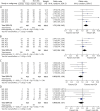General Anesthesia Compared With Non-GA in Endovascular Thrombectomy for Ischemic Stroke: A Systematic Review and Meta-analysis of Randomized Controlled Trials
- PMID: 36797071
- PMCID: PMC10115505
- DOI: 10.1212/WNL.0000000000207066
General Anesthesia Compared With Non-GA in Endovascular Thrombectomy for Ischemic Stroke: A Systematic Review and Meta-analysis of Randomized Controlled Trials
Abstract
Background and objectives: Endovascular thrombectomy (EVT) for large vessel occlusion ischemic stroke is either performed under general anesthesia (GA) or with non-GA techniques such as conscious sedation or local anesthesia alone. Previous small meta-analyses have demonstrated superior recanalization rates and improved functional recovery with GA when compared with non-GA techniques. The publication of further randomized controlled trials (RCTs) could provide updated guidance when choosing between GA and non-GA techniques.
Methods: A systematic search for trials in which stroke EVT patients were randomized to GA or non-GA was performed in Medline, Embase, and the Cochrane Central Register of Controlled Trials. A systematic review and meta-analysis using a random-effects model was performed.
Results: Seven RCTs were included in the systematic review and meta-analysis. These trials included a total of 980 participants (GA, N = 487; non-GA, N = 493). GA improves recanalization by 9.0% (GA 84.6% vs non-GA 75.6%; odds ratio [OR] 1.75, 95% CI 1.26-2.42, p = 0.0009), and the proportion of patients with functional recovery improves by 8.4% (GA 44.6% vs non-GA 36.2%; OR 1.43, 95% CI 1.04-1.98, p = 0.03). There was no difference in hemorrhagic complications or 3-month mortality.
Discussion: In patients with ischemic stroke treated with EVT, GA is associated with higher recanalization rates and improved functional recovery at 3 months compared with non-GA techniques. Conversion to GA and subsequent intention-to-treat analysis will underestimate the true therapeutic benefit. GA is established as effective in improving recanalization rates in EVT (7 Class 1 studies) with a high Grading of Recommendations, Assessment, Development, and Evaluations (GRADE) certainty rating. GA is established as effective in improving functional recovery at 3 months in EVT (5 Class 1 studies) with a moderate GRADE certainty rating. Stroke services need to develop pathways to incorporate GA as the first choice for most EVT procedures in acute ischemic stroke with a level A recommendation for recanalization and level B recommendation for functional recovery.
© 2023 American Academy of Neurology.
Conflict of interest statement
The authors report no relevant disclosures. Go to
Figures


References
-
- Campbell BCV, van Zwam WH, Goyal M, et al. . Effect of general anaesthesia on functional outcome in patients with anterior circulation ischaemic stroke having endovascular thrombectomy versus standard care: a meta-analysis of individual patient data. Lancet Neurol. 2018;17(1):47-53. doi:10.1016/S1474-4422(17)30407-6. - DOI - PubMed
Publication types
MeSH terms
LinkOut - more resources
Full Text Sources
Medical
